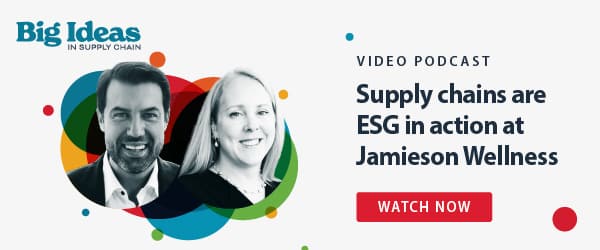Sustainability is an area of focus that many organizations are struggling to adopt holistically. For Jamieson Wellness, however, sustainability and the desire to create better outcomes for the planet is part of its DNA.
Jamieson Wellness is the Canadian leader in vitamins, minerals, and supplements, with a vision of bringing health and wellness to the world. Present in over 45 countries with over 10 distribution centers and a dedicated commitment to environmental, social, and governance (ESG), it has become a leader in upholding sustainable practices.
In our latest Big Ideas in Supply Chain video podcast, Andre Teixeira, VP of Global Supply Chain at Jamieson Wellness, and Dr. Anne Robinson, Chief Strategy Officer at Kinaxis, discuss Jamieson Wellness’ data-driven approach to operationalizing sustainability. Specifically, how its corporate mission to bring health and wellness to the world drove it to reshape its processes for the better.
Here are some key takeaways from the discussion.
How Jamieson Wellness is setting the pace for sustainability
While other organizations are struggling to operationalize their vision around sustainability, Jamieson Wellness sets itself apart by being guided by its core values. Bringing health and wellness to the world is its driving force, and this ideology comes from the executive leadership of an organization.
Its initiatives are rooted in the understanding that everything that moves across the globe is supply chain driven. Anne quotes Kinaxis CEO John Sicard by stating, “Just by its very nature, supply chains are consumers of the earth’s natural resources, so anything we can do to improve the supply chain is ultimately in service of humanity and Mother Earth.”
Andre believes that everything that moves across a supply chain is tied to the environment and that the decisions that are made operationally need to consider the implications of that. By looking at both the environment and the social aspect of economics, he believes that Jamieson Wellness is able to make better decisions for the planet.
As of now, its targets include reducing plastics by using recyclable plastics in 50% of its packaging, shrinking 75% of its landfill and using sustainable, raw materials in its products. Its supply chain has been working alongside its manufacturing department to operationalize its ESG goals, and it’s currently trying to improve the environmental impact of its transportation vehicles.
How organizations can include sustainability into their S&OP and IBP processes
Andre believes that supply chains have the power to impact the environment positively because organizations already have the levers needed to make a difference. He states that this can be done by leveraging the existing data that supply chains have and using it to make better decisions for the planet.
Supply chains, by nature, are constantly collecting and analyzing data to ensure KPIs and benchmarks are being met, and Jamieson Wellness uses this wealth of information to make better, data-driven decisions. Rather than pit its benchmarks against its sustainability goals, it takes a more holistic approach to include them alongside existing business KPIs.
When it comes to augmenting the sales and operations planning (S&OP) and integrated business planning (IBP) processes, the solution is the same. Andre explains this practically by stating, “When you have a bill of materials with products and descriptions, and quantities, how about having the environmental impact of those items in your bill of materials? … How about projecting your carbon emissions with your level of sales, with your forecasting?”
By leveraging the data in your organization’s IBP, you can make more mindful and sustainable decisions about sourcing goods and materials, transportation, and manufacturing. Analyzing this information not only allows for greater transparency from a cost and materials perspective but also allows companies to understand the impacts of different environmental factors like water consumption or carbon emissions.
The value of transparency in sustainability
Andre believes that transparency and sustainability belong in the same conversation, especially when it comes to giving consumers the option to make better buying decisions. Having full transparency in how products are being manufactured allows consumers to make purchases that have fewer environmental impacts, which could encourage other corporations to make more of an effort to embrace sustainability.
To hear more about sustainable practices in supply chain from Andre and Anne, watch the full video podcast here:






